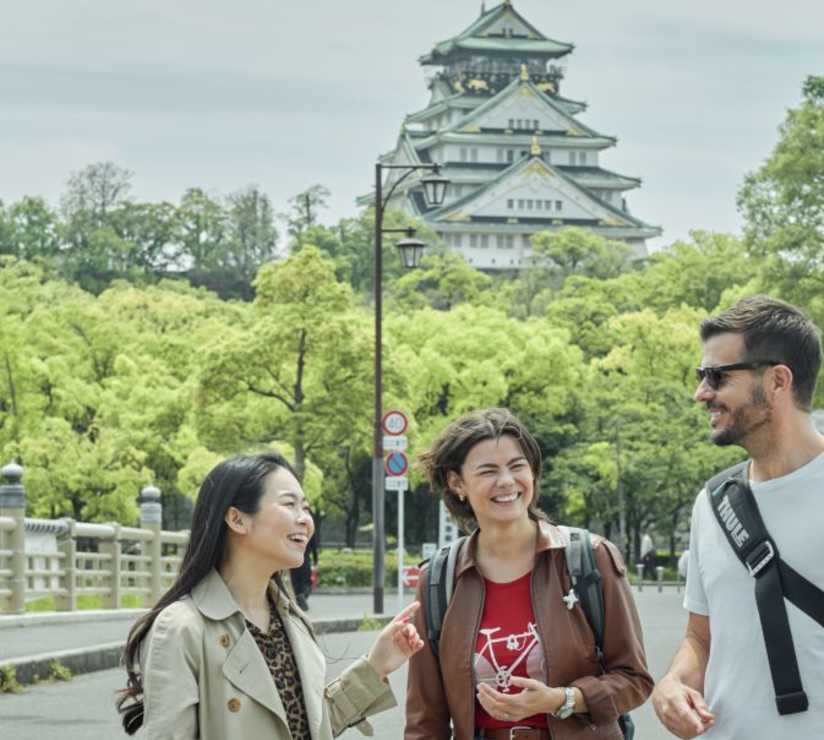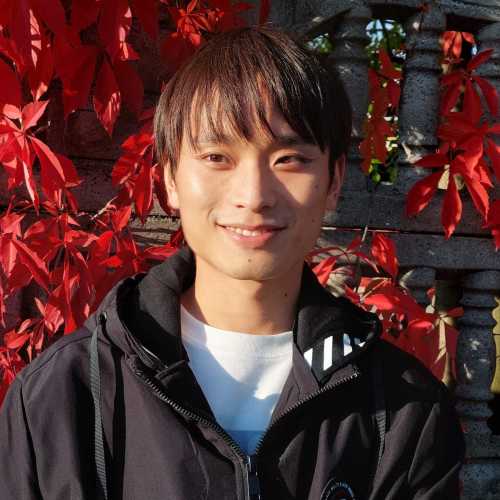Table Of Contents
- Introduction to the best food districts in Osaka
- Dotonbori: Osaka's Iconic Food District
- Kuromon Ichiba Market: The "Kitchen of Osaka"
- Shinsaibashi: Where Shopping Meets Gourmet Dining
- Umeda: Gourmet Experiences in the Sky
- Namba: The Heart of Southern Osaka's Food Scene
- Osaka Street Food: Essential Dishes to Try
- Hidden Gems in Osaka's Foodie Neighborhoods
- Navigating Osaka's Shopping Streets for Food
- Budget-Friendly Options
- Seasonal Food Experiences in Osaka
- Food Souvenirs from Osaka's Districts
- The Cultural Significance of Osaka's Food Districts
- Conclusion: A Living Expression of the City’s Identity

Osaka's food districts come alive at night, earning the city its reputation as "Japan's Kitchen" Photo by Willian Justen de Vasconcellos Pexels

Street vendors skillfully preparing takoyaki, one of Osaka's most famous street foods Photo by Thành Văn Đình Pexels
Introduction to the best food districts in Osaka
Welcome to Osaka, a city where culinary exploration isn't just an activity—it's a way of life. These districts offer some of the most authentic and diverse food experiences in all of Japan. From bustling market streets to sophisticated dining neighborhoods, Osaka's food districts represent the heart and soul of Japanese culinary culture.
Unlike Tokyo's polished dining scene, the food in Osaka embraces bold flavors, casual dining atmospheres, and a contagious enthusiasm for eating well. Locals even have a term for it: "kuidaore," which translates to "eat until you drop"—a philosophy that has shaped the city's vibrant food landscape.
Hungry for the real Osaka? With a local host by your side, you’ll dodge the guidebook crowds and dive straight into the city’s most iconic food districts—just like a friend showing you around their neighborhood. We’ll point you toward the dishes locals actually eat, help you uncover hidden street food gems, and share the kind of stories you only hear when you're chatting with someone who’s grown up eating takoyaki every week. Whether it’s your first visit or you’re back for another round, this is your invitation to experience Osaka’s food culture the way it’s meant to be: unscripted, authentic, and one unforgettable bite at a time.
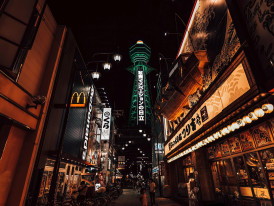
Kushikatsu, Shinsekai's signature dish, being prepared with the iconic Tsutenkaku Tower in the background Photo by Nguyen Hung Pexels
Dotonbori: Osaka's Iconic Food District
When people think of Osaka’s food districts, Dotonbori is usually the first that comes to mind. Located in Chuo Ward and just a five-minute walk from Namba Station, this vibrant canal-side entertainment area is the epicenter of Osaka's food culture. With the iconic Ebisubashi Bridge offering front-row views of neon lights and street food stalls, it’s a must-visit for any food lover looking to dive into the city's bold, flavorful spirit.
What Makes Dotonbori Special
Dotonbori is where Osaka turns up the volume. Towering food billboards, glowing neon signs, and the iconic Glico Running Man light up the night sky, casting reflections on the canal that winds through the heart of it all. The Dotonbori River isn’t just a landmark—it’s the lifeline of the district, lined with eateries, entertainment, and photo ops at every turn.
Come evening, the energy in this bustling area is electric—locals and travelers alike pack the streets, drawn by the sizzle of takoyaki stalls and the buzz of riverside restaurants.
Dotonbori's Street Food Scene
The street food options in Dotonbori are seemingly endless. You'll find vendors selling takoyaki (octopus balls), okonomiyaki (savory pancakes), and kushikatsu (deep-fried skewers of meat and vegetables). The aromas wafting through the air make it impossible to walk through without stopping for a bite.
Notable Restaurants in Dotonbori
Beyond the bustling food stalls, Dotonbori is also home to some of Osaka’s most iconic restaurants. Don’t miss Kani Doraku, famous for its giant mechanical crab waving down from the facade, or Kinryu Ramen, with a dragon curling across its storefront and piping-hot bowls of late-night comfort. Be sure to stop by Takoya Dotonbori Kukuru, a local favorite known not only for some of the best takoyaki in town but also for its seriously addictive fried chicken—crispy, juicy, and absolutely worth the queue.
Step back in time in Shinsekai, a nostalgic district that offers a glimpse into pre-war Osaka alongside some of the city's most beloved street food specialties.
The History Behind Shinsekai
Designed in 1912 with Paris and Coney Island as inspiration, Shinsekai (meaning "New World") retains much of its retro charm. The district is dominated by Tsutenkaku Tower, Osaka's own Eiffel Tower-inspired landmark that watches over this unique food neighborhood.
Kushikatsu: Shinsekai's Signature Dish
Shinsekai is synonymous with kushikatsu—deep-fried skewers of meat, seafood, and vegetables served with a special dipping sauce. The golden rule: no double-dipping! The district's most famous kushikatsu restaurant, Daruma, has been serving these crispy delights since 1929.
Beyond Kushikatsu: Other Food Offerings
While kushikatsu reigns supreme, Shinsekai offers plenty of other delicious food in Osaka. Try fugu (pufferfish) at one of the specialized restaurants, sample doteyaki (beef tendon stew), or enjoy a bowl of hot kitsune udon topped with sweet fried tofu.
Looking for a private city experience in Osaka?
Explore the city with a local who plans a private day just for you; no groups, no scripts.
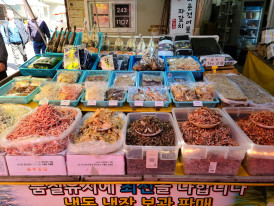
Fresh seafood vendors at Kuromon Ichiba Market offering everything from scallops to uni Photo by KG Baek on Unsplash
Kuromon Ichiba Market: The "Kitchen of Osaka"
Often called "Osaka's kitchen," Kuromon Ichiba Market has been feeding locals and visitors alike for nearly 200 years. A ten-minute walk from Namba station, this covered market street is paradise for food lovers seeking fresh ingredients and ready-to-eat delicacies.
The History of Kuromon Market
Dating back to 1822, Kuromon Ichiba Market earned its name ("Black Gate Market") from the black gate of a nearby temple. Today, the market stretches for about 600 meters and houses approximately 150 shops and stalls.
Seafood Treasures at Kuromon
The market is renowned for its incredible selection of fresh seafood. Watch as vendors grill fresh scallops, sea bream, oysters, and unagi (eel) right before your eyes. Don't miss the opportunity to try uni (sea urchin), fatty tuna, or the market's famous crab legs.
Beyond Seafood: Other Market Delights
While seafood may be the star, Kuromon Market has much more to offer. Sample fresh fruits, traditional Japanese desserts, pickled vegetables, and specialty teas. It’s also a fantastic place to enjoy Japanese food staples like takoyaki, served fresh from bustling Osaka street food stalls.
Tips for Visiting Kuromon Market
Visit in the morning for the freshest selection and fewer crowds. Many shops offer small seating areas where you can enjoy your purchases immediately. Bring cash, as some smaller vendors don't accept credit cards.
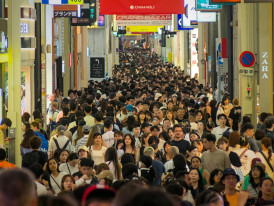
The bustling Shinsaibashi-suji shopping arcade combines retail therapy with culinary delights Photo by M K Pexels
Shinsaibashi: Where Shopping Meets Gourmet Dining
Shinsaibashi combines Osaka's love for food with its passion for shopping, creating one of the city's most dynamic districts for both retail therapy and culinary exploration.
Navigating Shinsaibashi-suji Shopping Arcade
The heart of Shinsaibashi is its covered shopping street, Shinsaibashi-suji, which stretches approximately 600 meters. This pedestrian paradise is lined with international brands, local boutiques, and countless dining options.
High-End Dining in Shinsaibashi
Shinsaibashi hosts some of Osaka's most sophisticated restaurants, including Michelin-starred establishments. From traditional kaiseki (multi-course Japanese dining) to innovative fusion cuisine, the district caters to discerning food enthusiasts.
Casual Eats and Street Food
Despite its upscale reputation, Shinsaibashi offers plenty of affordable food in Osaka. Duck into side streets to find casual izakayas (Japanese pubs), ramen shops, and street food vendors selling everything from melon pan (sweet bread) to takoyaki.
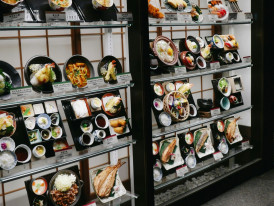
The meticulously arranged food displays at an Umeda department store's basement food hall Photo by Falco Negenman on Unsplash
Umeda: Gourmet Experiences in the Sky
Towering above the city bustle, Osaka's northern commercial hub—anchored by Umeda Station and walking distance from Osaka Station—offers a gourmet experience with a view. In sleek department store towers and luxury hotels, you'll find some of the city's most refined Japanese food, elegant sushi bars, and panoramic dining rooms that make every meal unforgettable.
Department Store Food Halls
The basement food floors (depachika) of Umeda's department stores like Hankyu, Daimaru, and Grand Front Osaka offer spectacular displays of Japanese and international cuisine. These food halls are perfect for picking up bento boxes, confectionery, and regional specialties.
Sky-High Dining Experiences
Umeda's skyscrapers offer dining with a view. The upper floors of buildings like Umeda Sky Building and Grand Front Osaka house restaurants ranging from traditional Japanese cuisine to international fine dining, all with spectacular city panoramas.
Whisky bars and Craft Cocktails
Umeda leads Osaka's craft cocktail scene, with hidden bars specializing in Japanese whisky and innovative cocktails. These intimate establishments often showcase Japanese bartending techniques that elevate mixology to an art form.
Near Osaka Station
Just a short walk from Osaka Station, Umeda's food scene offers convenient dining options for travelers. Many department stores are directly connected to the station, making them perfect for a quick meal before catching a train.
What if your day in Osaka was planned by someone who knows it — and you?
City Unscripted matches you with a local host who creates a private experience based on your interests, not a set route.
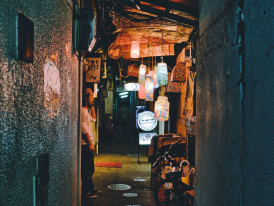
A narrow yokocho (alley) in Namba lined with intimate restaurants and bars Photo by Tuan Nguyen on Unsplash
Namba: The Heart of Southern Osaka's Food Scene
While often overshadowed by nearby Dotonbori, Namba itself is a major food destination with everything from hidden yokocho (alley) dining to modern food halls.
Navigating Namba's Food Complexes
Modern food complexes like Namba Parks and Namba City offer curated dining experiences spanning multiple floors. These centers house everything from traditional Japanese cuisine to international restaurants, perfect for groups with diverse tastes.
Hidden Yokocho Dining
Explore the narrow alleyways branching off from main streets to discover yokocho dining districts. These atmospheric lanes house tiny restaurants and bars, many seating just 6-10 customers, offering intimate dining experiences and local specialties.
Namba's Connection to Street Food
As one of Osaka's transportation hubs, Namba is an excellent place to sample Osaka street food on the go. Look for vendors selling melon pan, taiyaki (fish-shaped cakes with sweet fillings), and other portable treats perfect for snacking while exploring.

Close-up of takoyaki being prepared on a specialized grill – watch for the skillful rotation technique
Osaka Street Food: Essential Dishes to Try
No exploration of the city's food districts would be complete without sampling the city's legendary street food. Here are the must-try dishes that define Osaka's casual food culture.
Takoyaki: Osaka's Most Famous Street Food
These ball-shaped snacks filled with octopus pieces are the quintessential Osaka street food. Watch as vendors skillfully rotate the batter in special molded pans, then top the finished octopus balls with takoyaki sauce, mayonnaise, bonito flakes, and seaweed powder.
Okonomiyaki: Savory Pancake Perfection
Often described as a Japanese savory pancake, okonomiyaki is a hearty dish containing batter, cabbage, protein (often pork or seafood), and various toppings. Osaka-style okonomiyaki mixes all ingredients together, unlike the layered Hiroshima style.
Kushikatsu: Deep-Fried Delights
These deep-fried skewers of battered meat, seafood, and vegetables are particularly associated with Shinsekai district. Remember the golden rule: no double-dipping in the communal sauce!
Negiyaki: The Osaka Local's Choice
Less known to travellers but beloved by locals, negiyaki is similar to okonomiyaki but features green onion as the main ingredient instead of cabbage. It's thinner and often served rolled up with various fillings.
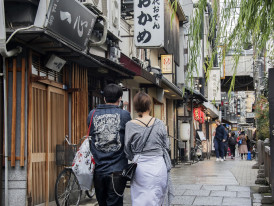
The atmospheric stone-paved alley of Hozenji Yokocho, a hidden gem steps away from Dotonbori
Hidden Gems in Osaka's Foodie Neighborhoods
Beyond the famous spots, each district contains hidden gems known primarily to locals. Here are some lesser-known areas worth exploring for food enthusiasts.
Temma Tenjin: A Local's Market
While tourists often flock to Kuromon Ichiba Market, locals tend to gravitate toward Temma Tenjin Market—a smaller, less crowded spot that feels more like a neighborhood favorite. This hidden gem has all the essentials: fresh produce, a proper fish market with gleaming seafood, and top-quality ingredients perfect for making sushi at home—all without the tourist markup. It’s where Osaka residents go when they’re after flavor, not fanfare.
Hozenji Yokocho: Atmospheric Dining Alley
Just steps away from bustling Dotonbori lies Hozenji Yokocho, a narrow stone-paved alley lined with traditional restaurants and izakayas. The atmospheric lane is named after the nearby Hozenji Temple and offers a peaceful contrast to Dotonbori's energy.
Kyobashi: The Businessperson's Food District
Kyobashi is where Osaka’s office workers wind down after a long day—and where hungry travelers can eat like a local. The streets around the station are packed with budget-friendly izakayas, ramen spots, and specialty restaurants offering incredible quality for the price. Whether you’re craving a comforting bowl of noodles, grilled skewers with a cold beer, or a delicious dessert to top it all off, Kyobashi delivers. It’s one of the best places to eat in Osaka without breaking the bank. Huge selection. Great value. Local flavor.
Tip
We match you with the right host, not just any guide.Want to experience the real Osaka with someone who lives there?
A fully private experience, planned and led by a local host who tailors the day to you
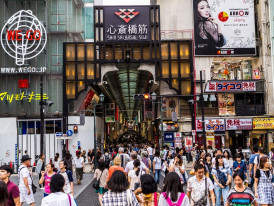
A typical covered shopping street in Osaka with food vendors interspersed among retail shops
Navigating Osaka's Shopping Streets for Food
Osaka's shopping street culture is deeply intertwined with its food scene. These covered arcades combine retail therapy with culinary exploration.
Tenjinbashisuji: Japan's Longest Shopping Street
Stretching 2.6 kilometers, Tenjinbashisuji is Japan's longest shopping street and home to approximately 600 shops, including numerous food vendors and restaurants. The southern portion tends to have more tourist-oriented options, while the northern stretch offers more local flavors.
Sennichimae: The Food-Focused Shopping Street
Located near Namba, Sennichimae shopping street specializes in food-related businesses. From restaurant supply stores selling Japanese knives to specialty food shops, this arcade is paradise for culinary enthusiasts.
Nipponbashi: Den Den Town's Hidden Food Scene
While known primarily as Osaka's electronics district, Nipponbashi (nicknamed Den Den Town) also houses excellent, affordable restaurants catering to shop employees and visitors. Look for specialized eateries featuring regional Japanese cuisines.
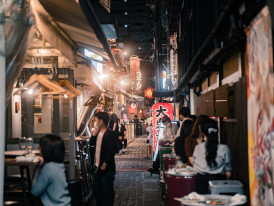
A typical tachinomiya (standing bar) offering affordable food and drinks Photo by Satoshi Hirayama Pexels
Budget-Friendly Options
Osaka proudly maintains its reputation for offering excellent food in Osaka at reasonable prices. Here's how to enjoy the city's culinary scene without breaking the bank.
Standing Bars and Restaurants
Tachinomiya (standing bars) and tachigui (standing restaurants) offer some of the most budget-friendly dining experiences in Osaka. These no-frills establishments sacrifice seating for savings, passing the reduced overhead costs to customers.
Department Store End-of-Day Sales
Visit department store food halls about an hour before closing time when many vendors discount their remaining fresh items by 30-50%. This is a great way to sample high-quality prepared foods at a fraction of the regular price.
Lunchtime Set Menus
Many restaurants that serve expensive dinners offer surprisingly affordable lunch sets (teishoku). These typically include a main dish, rice, miso soup, and pickles, providing excellent value for money.

Cherry blossom viewing (hanami) food stalls along an Osaka river in spring Photo by James Pere on Unsplash
Seasonal Food Experiences in Osaka
Osaka's food scene changes dramatically with the seasons, with each district offering special seasonal delicacies and food events throughout the year.
Spring: Cherry Blossom Food Festivals
During cherry blossom season (usually late March to early April), many Osaka foodie zones host special food festivals. Parks and riverside areas fill with food stalls selling seasonal specialties to enjoy while viewing the blossoms.
Summer: Rooftop Beer Gardens
Umeda department stores transform their rooftops into beer gardens during summer months, offering all-you-can-eat-and-drink deals featuring grilled meats, cold noodles, and other summer specialties.
Autumn: Seasonal Ingredients
Fall brings an abundance of seasonal ingredients to Osaka's markets and restaurants. Kuromon Ichiba Market displays autumn specialties like matsutake mushrooms, while traditional restaurants offer special moon-viewing (tsukimi) dishes.
Winter: Hot Pot and Comfort Foods
Winter transforms Osaka's food landscape, with restaurants featuring hot pot dishes like shabu-shabu and sukiyaki. Street vendors switch to warm comfort foods like oden (simmered dish) and roasted sweet potatoes.
Ready to plan your perfect day in Osaka?
Start your experienceFood Souvenirs from Osaka's Districts
Don't leave Osaka without bringing home some edible souvenirs from its famous food districts.
Best Food Souvenirs from Each District
Each district specializes in different souvenirs: Dotonbori for popular snack brands, Kuromon Ichiba Market for tea and dried seafood, department stores in Umeda for beautifully packaged sweets, and specialty shops in Shinsaibashi for artisanal items.
Packaged Versus Fresh Souvenirs
Consider how long your journey home will be when purchasing food souvenirs. Packaged snacks like Glico Pocky, regional Kit Kats, and sembei (rice crackers) travel well, while more perishable items require proper planning.
Where to Find the Best Deals
Department store basement food halls offer high-quality but premium-priced souvenirs. For better deals, check discount shops like Don Quijote or specialty snack shops in shopping street arcades where locals shop.
Beautifully packaged food souvenirs from Osaka, perfect for bringing home

A veteran chef passing down traditional Osaka cooking techniques to the next generation Photo by Steven Su on Unsplash
The Cultural Significance of Osaka's Food Districts
Grasping the cultural backdrop of Osaka’s food districts deepens your appreciation for the city’s distinct and flavorful culinary scene.
Osaka's "Kuidaore" Philosophy
The concept of "kuidaore" (eat until you drop) reflects Osaka's merchant history and the city's passion for good food regardless of cost. This philosophy shapes the abundance and variety found in Osaka's food landscape.
The Merchant History Behind Food Districts
As a historical merchant city, Osaka developed specialized food districts to serve different commercial needs. Many districts like Kuromon Ichiba Market began as suppliers for professional chefs before opening to the public.
Food as Communication in Osaka Culture
In Osaka's culture, sharing food is a primary form of social bonding. The casual, communal nature of much of the city's dining reflects Osakans' friendly, outgoing character compared to other Japanese cities.
Preserving Culinary Heritage
Many establishments in Osaka’s traditional food districts represent a long line of family ownership, preserving recipes and techniques that date back decades or even centuries. Their kitchens hum with stories passed down through time—each dish a living testament to the city’s rich culinary history. These businesses form an important part of Osaka’s intangible cultural heritage.
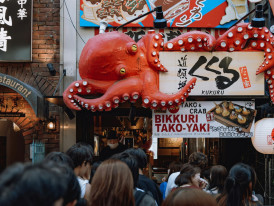
Visitors enjoying the convivial atmosphere of Osaka's foodie culture – the perfect end to a culinary journey Photo by Shriram Nagarajan on Unsplash
Conclusion: A Living Expression of the City’s Identity
These iconic food areas in Osaka represent more than just places to eat; they capture the spirit of the city. From the theatrical street food stands of Dotonbori to the historic market lanes of Kuromon Ichiba Market, each district tells a story about Osaka's evolution as Japan's kitchen.
What makes these districts special isn't just the quality of the food—though that's certainly exceptional—but the infectious enthusiasm Osakans have for sharing their culinary heritage. The city's food culture encourages interaction, whether you're watching takoyaki being made right before your eyes or sitting at a counter where the chef personally serves each delicious food.
As you explore these vibrant neighborhoods, remember that food in Osaka is meant to be experienced with all senses. Take in the sizzling sounds of okonomiyaki on the grill, admire the artful presentation of a kaiseki meal, inhale the enticing aromas wafting from street vendors, and most importantly, engage with the people who make Osaka's food scene so special.
For a deeper understanding of individual dishes and their history, check out our comprehensive Osaka food guide, which complements this district-by-district exploration.
Whether you're slurping ramen at one of the many ramen restaurants, splurging on premium beef in Umeda, or hunting for the perfect takoyaki in Dotonbori, Osaka’s culinary hubs offer adventures to suit every taste and budget. In a city that lives by the motto "kuidaore," the only real mistake is not coming hungry enough to try it all.
What if your day in Osaka was planned by someone who knows it — and you?
City Unscripted matches you with a local host who creates a private experience based on your interests, not a set route.
Want to experience the real Osaka with someone who lives there?
A fully private experience, planned and led by a local host who tailors the day to you
